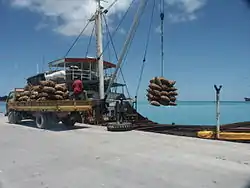KoreKorea
KoreKorea was a term used for girls in Kiribati who Korean fishermen paid for sex.[2] They are now called ainen matawa locally "in deference to Korean sensitivities", because the word "Korekorea" was overtly linked to the "principal nationality of their clients".[3] The girls are around the age of eighteen and are even as young as fourteen years old.[4][5] They board foreign fishing vessels and engage in sex in exchange for money, clothes and fish.[3][6]
Awareness
A 2005 news article in The Korea Times said that, according to ECPAT-Korea, "te korekorea" are "the best known cases of commercial sexual exploitation of children".[7]
Countries involved
Involvement of Kiribati
A 2006 news article in The Sydney Morning Herald said that "all Korean fishing boats" had been banned by Kiribati from going to Kiribati's ports for a time in 2003 following reports in The Korea Herald "that 30 to 50 girls, mostly under age, were servicing the Korean fishermen."[8]
The KoreKorea issue is being addressed by a Korean institution in collaboration with the Kiribati Government cooperating with the ILO Youth unemployment programme and with the New Zealand's International Aid and Development Agency (NZAID).[9]
Involvement of South Korea
A 2005 news article in The Korea Times said that the National Youth Commission would try to get the "Korean fishermen" punished as South Korea's "anti-juvenile-prostitution law" did not allow for "sex trade".[7]
Mixed children
A 2005 news article in The Hankyoreh said that children had been made from "Some" "KoreKorea" and "Korean fishermen".[2]
A 2010 report made by the International HIV Research Group of the University of New South Wales said that children had been made from "a number" of ainen matawa" and "Korean seafarers", and the report said that the Korean fathers send financial support to these children.[3]
Men who have sex with ainen matawa
Condom use
A document named "Synthesis_Kiribati_2013" on the Burnet Institute's website said that "condom use is intermittent" among the "ainen matawa".[10]
Ainen matawa
Age of ainen matawa
A 2005 news article in The Hankyoreh said that the KoreKorea females were about 18 years old.[2]
A 2006 report by UNICEF Pacific said that "80 young te korekorea... had visited boats in port in 2000".[6]
A 2007 news article in The Korea Times said that "te korekorea" were "teenage girls", and 8 of 24 of the interviewed "te korekorea" were younger than 19 and one was 14 years old. The news article also said that the age when "te korekorea" first start was "getting younger".[11]
A 2008 report by the Pacific Islands Forum Fisheries Agency said that "Teenage girls from the outer islands" were the group who were "particularly vulnerable to becoming Te korekorea".[5]
A 2010 report made by the International HIV Research Group of the University of New South Wales said that the "ainen matawa" were "young women".[3]
A 2012 document made by the Kiribati Local Government Association explained the term "ainen matawa" with the words "teenage prostitution, involving very young girls".[12]
A web page on UNICEF's website said that the "korekorea" were "young women".[1]
Stigma of being ainen matawa
A 2013 document by the World Health Organization said that "ainen matawa" were inhibited from utilizing "sexual and reproductive health services", because of the "stigma, discrimination, violence and/or social exclusion" that they faced.[13]
A 2013 report on the United States Department of State's website said that "ainen matawa" had a stigma within their society.[14]
A 2014 report by WorldFish said that "ainen matawa" were "socially marginalized" for prostituting themselves, because what they were doing went against the values of their culture.[15]
See also
- Prostitution in Kiribati
- Prostitution in South Korea
- Lai Đại Hàn Prostitution and rape by Korean soldiers in Vietnam
- Kopino children of mixed Korean and Filipino descent to an unwed Filipina mother
References
- Harborow, H. The Pacific's Hidden Trade. UNICEF. Retrieved November 24, 2016, from link
- The Shame in 'KoreKorea'. (2005). The Hankyoreh. Retrieved November 24, 2016, from link
- "McMillan K., and H. Worth (2010) Risky Business Kiribati: HIV prevention amongst women who board foreign fishing vessels to sell sex. International HIV Research Group, UNSW, Sydney" (PDF). Archived from the original (PDF) on October 30, 2013. Retrieved 2013-06-15.
- "2012 Trafficking in Persons Report - Kiribati". United States Department of State / UNHCR. 19 June 2012.
- "Sullivan, N. & Ram-Bidesi, V. (2008). Gender Issues in Tuna Fisheries Case Studies in Papua New Guinea, Fiji and Kiribati" (PDF). Archived from the original (PDF) on February 20, 2011. Retrieved 2017-05-07.
- Commercial Sexual Exploitation of Children (CSEC) and Child Sexual Abuse (CSA) in the Pacific: A Regional Report. (2006). UNICEF Pacific. Retrieved November 24, 2016, from link
- "Kim, C. (2005). Korean Fishermen Blamed for Child Sex Trade in Kiribati. The Korea Times". Archived from the original on September 27, 2007. Retrieved 2016-11-26.
- Tiniest nations caught in a net. (2006). The Sydney Morning Herald. Retrieved November 25, 2016, from link
- "Kiribati - Country baselines under the ILO Declaration Annual Review (2000-2008): Effective abolition of child labour". International Labour Organization. 15 February 2008.
- Synthesis_Kiribati_2013. Burnet Institute. link
- "Rahn, K. (2007). Sailors Blamed for Child Sex Trade. The Korea Times". Archived from the original on September 27, 2007. Retrieved 2016-11-25.
- Strategic Plan 2012-2014. (2012). Kiribati Local Government Association. Retrieved November 24, 2016, from link
- Rasanathan, J.K. et al. (2013). Measuring and responding to violence against women in Kiribati: Action on gender inequality as a social determinant of health. World Health Organization: Western Pacific Region. Retrieved November 27, 2016, from link
- 2013 Trafficking in Persons Report. (2013). U.S. Department of State. Retrieved November 25, 2016, from link
- Campbell, B., Hanich, Q. (2014). Fish for the future: Fisheries development and food security for Kiribati in an era of global climate change. WorldFish, Penang, Malaysia. Project Report: 2014-47. Retrieved November 25, 2016, from link

